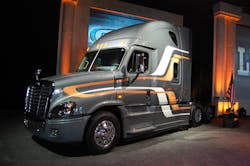Washington, DC. The next generation of Freightliner Trucks’ over-the-road Cascadia tractor will achieve 5% better fuel economy than the current model and 7% better than the first generation EPA-2010 compliant model, according to officials of Daimler Trucks North America. Scheduled to go into production in early 2013 as a 2014 year model, the Cascadia Evolution combines aerodynamic and proprietary drivetrain advances in an integrated package to deliver that efficiency improvement, according to Martin Daum, DTNA president & CEO.
Accounting for roughly half of the fuel efficiency gains, aerodynamic changes for the new Evolution model include frontal area updates for better air flow, elliptical shaped mirrors, a new windshield seal, an antenna integrated into the sleeper roof, new wheel covers and extended chassis and side fairings, according to Mark Lampert, sr. vp for sales and marketing.
Another major contributor to the efficiency gains comes from a new version of DTNA’s proprietary Detroit DD15 liter engine, Lampert said. The new DD15, which Freightliner will only offer in the Cascadia Evolution, features an asymmetrical turbocharger and an amplified common rail fuel system with higher injection pressures. One hundred lbs. lighter than the current DD15, it also features a new water pump design that lowers parasitic power loss and improved electronics.
The only way to achieve such a significant improvement is through “a total systems approach,” Lampert said. “You can’t simply optimize one component; you’ll have to deal with the entire vehicle.”
Given that close integration, the Cascadia Evolution elements will only be available as a complete package and not as individual components, he said.
The fuel efficiency gains for the new model were demonstrated in a 2,400-mi. cross country test that ran a Cascadia Evolution and an EPA-2010 compliant Cascadia. Both were 225-in. wheelbase tractors with 72-in. raised roof sleepers, Eaton UltraShift Plus transmissions and Detroit tandem rear axles loaded to 76,000 lbs. GVW and set to cruise at 62 mph, according to David Hames, gm for marketing and strategy.
Speaking at a press conference before the annual Freightliner dealers’ meeting, Hames said drivers and trailers were swapped half way through each day to minimize variables and fuel consumption was measured at the end of each day by a third-party. The Cascadia Evolution’s fuel economy advantage varied between 6.3 and 8.3% depending on environmental conditions encountered in the trip from Portland, OR, to Gastonia, NC, for an overall average improvement of 7%, he said.
A third vehicle - an “optimally spec’d” Cascadia Evolution was also run alongside the two test trucks. Those specs featured a Detroit DT12 automated manual transmission, a 6x2 drivetrain and trailer aerodynamics developed by Daimler engineers.
With the same gross weight and cruising speed as the two test trucks, the highly spec’d Evolution averaged 9.1 mpg over the 2,400 mi., according to Hames. Later on a closed-course track, it also ran for 1,000 hours nonstop at 60 mph with a 10.67 mpg average, he said.
Along with the Cascadia Evolution introduction, DTNA also announced results of a cross country tour by one of its CNG models, a Cascadia 113-in. BBC day cab model powered by a Cummins Westport ISX12G heavy-duty natural gas engine. Traveling from Los Angeles to D.C. Over seven days, it delivered a 30,000 lb. load in a 53-ft. trailer stopping only at public CNG fueling stations.
Compared to diesel prices along the route, the CNG truck saved $700 in fuel costs, according to Daum. “The CNG tour clearly demonstrated the ability to drive significant distances in a heavy-duty CNG-powered truck,” he said.
Demonstration test versions of the new Cascadia Evolution are currently being placed with fleet customers with production of the 2014 model slated to begin in the first quarter of 2013, Daum said.
About the Author
Jim Mele
Jim Mele is a former longtime editor-in-chief of FleetOwner. He joined the magazine in 1986 and served as chief editor from 1999 to 2017.
